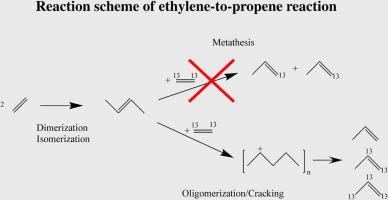Journal of Catalysis ( IF 6.5 ) Pub Date : 2020-06-16 , DOI: 10.1016/j.jcat.2020.06.009 Uwe Rodemerck , Evgenii V. Kondratenko , Mariana Stoyanova , David Linke

|
The reaction mechanism of the direct conversion of ethylene to propene over Ni-containing catalysts is assumed in literature to comprise (i) ethylene dimerization to 1-butene, (ii) butene isomerization and (iii) metathesis of 2-butene with ethylene to propene. To elucidate if the third step of this reaction is really metathesis, the reaction of 13C-labelled ethylene with 12C-trans-2-butene was studied and the distribution of 12C and 13C atoms in propene and the other reaction products was measured by a gas chromatograph with mass spectrometer detector. Since only traces of propene containing one 13C atom were observed, metathesis cannot play a substantial role in propene formation. This conclusion was confirmed by the lack of other products that would have been formed in secondary reactions by metathesis. The observed reaction products and the distribution of 12C and 13C atoms therein strongly suggest a reaction mechanism involving C-C olefin coupling reactions at Ni2+ surface sites and cracking reactions of the formed higher olefins at acidic sites of the catalysts. The proposed mechanistic pathway explains also the differences in the distribution of 12C and 13C atoms in propene formed over the two catalysts differing in their nature of Ni2+ surface species and acidic sites.
中文翻译:

同位素标记反应物研究乙烯-丙烯反应的反应网络
文献中假定乙烯在含镍催化剂上直接转化为丙烯的反应机理包括(i)乙烯二聚为1-丁烯,(ii)丁烯异构化和(iii)2-丁烯与乙烯复分解为丙烯。 。为了阐明该反应的第三步是否真的是复分解反应,研究了13 C标记的乙烯与12 C-反式-2-丁烯的反应,并分析了12 C和13 C原子在丙烯和其他反应产物中的分布。通过带有质谱仪检测器的气相色谱仪测量。由于仅微量的丙烯含有一种13观察到碳原子,复分解不能在丙烯形成中发挥实质性作用。缺乏通过复分解在次级反应中会形成的其他产物,证实了这一结论。观察到的反应产物以及其中的12 C和13 C原子的分布有力地表明了一种反应机理,涉及在Ni 2+表面位点处的CC烯烃偶联反应和在催化剂的酸性位点处形成的高级烯烃的裂化反应。拟议的机理途径还解释了在两种催化剂上形成的丙烯中12 C和13 C原子的分布差异,其本质上具有不同的Ni 2+表面种类和酸性部位。











































 京公网安备 11010802027423号
京公网安备 11010802027423号